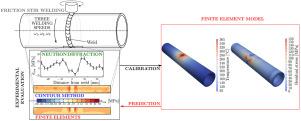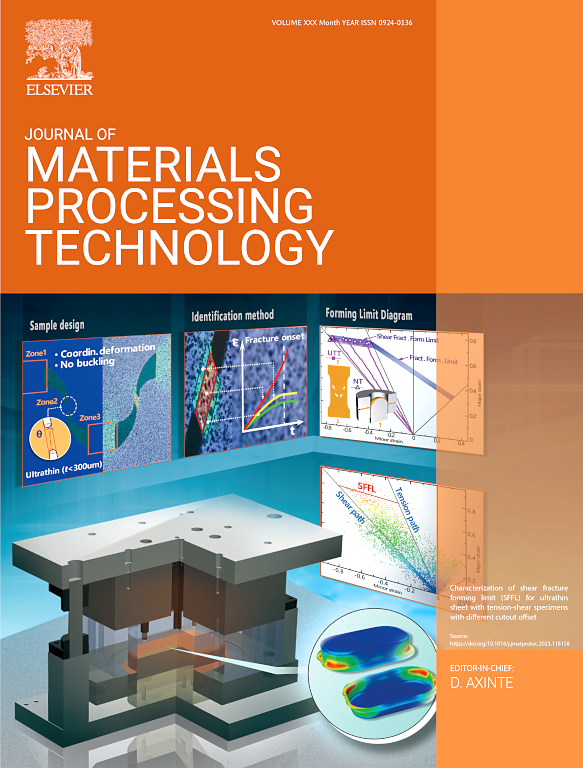AA6082-T6搅拌摩擦焊管径残余应力的多模态试验与数值计算
IF 6.7
2区 材料科学
Q1 ENGINEERING, INDUSTRIAL
Journal of Materials Processing Technology
Pub Date : 2024-11-23
DOI:10.1016/j.jmatprotec.2024.118665
引用次数: 0
摘要
虽然搅拌摩擦焊在平面焊件中的残余应力问题已经得到了广泛的研究,但对于曲面焊件的残余应力问题却没有得到足够的重视。为了全面解决这一差距,本文研究了三种AA6082-T6 FSW管(外径37.5 mm ×厚度3mm)在不同进给速度(即50、75和100 mm/min)下制造的RS。RS评价采用中子衍射法和轮廓法两种独立的实验方法进行交叉验证。利用之前获得的实验结果,建立并校准了一种新的多物理场有限元(FE)模型,以阐明产生RS的关键物理机制。分析结果揭示了类似于FSW平对接焊缝的m形箍RS模式,但其强度较低,范围在- 20 MPa至65 MPa之间,很可能是由于不同的热历史。轴向RS在-20 MPa和20 MPa之间振荡,而径向分量则可以忽略不计。有限元模型还展示了进给速度、插入力和外部夹紧条件如何改变RS值,并确定75 mm/min为将箍箍峰值RS降至40 MPa的最佳速度。本文章由计算机程序翻译,如有差异,请以英文原文为准。

Multimodal experimental and numerical evaluation of Residual Stress in AA6082-T6 Friction Stir Welding pipe girths
Although Residual Stress (RS) induced by Friction Stir Welding (FSW) has been widely investigated for planar weldments, the same attention has not been paid as far as the curved variant is concerned. To comprehensively address this gap, the present paper studies the RS in three AA6082-T6 FSW pipes (37.5 mm outer diameter 3 mm thickness) manufactured with varying feed speeds, i.e. 50, 75, 100 mm/min. RS evaluations were cross-validated by two independent experimental methods, i.e. Neutron Diffraction and Contour Method. A novel multi-physics Finite Element (FE) model was implemented and calibrated using the previously obtained experimental outcomes to shed light on the key physical mechanism responsible for the arising of RS. The analysis unveiled M-like hoop RS patterns akin to flat FSW butt-welds but having lower magnitudes ranging from −20 MPa to 65 MPa, most likely due to the different thermal histories. The axial RS oscillates between -20 MPa and 20 MPa, whereas the radial component turned out to negligible. The FE model also demonstrated how feed speed, plunge force, and external clamping conditions alter RS magnitude while identifying 75 mm/min as the optimal speed that minimises the peak hoop RS to 40 MPa.
求助全文
通过发布文献求助,成功后即可免费获取论文全文。
去求助
来源期刊

Journal of Materials Processing Technology
工程技术-材料科学:综合
CiteScore
12.60
自引率
4.80%
发文量
403
审稿时长
29 days
期刊介绍:
The Journal of Materials Processing Technology covers the processing techniques used in manufacturing components from metals and other materials. The journal aims to publish full research papers of original, significant and rigorous work and so to contribute to increased production efficiency and improved component performance.
Areas of interest to the journal include:
• Casting, forming and machining
• Additive processing and joining technologies
• The evolution of material properties under the specific conditions met in manufacturing processes
• Surface engineering when it relates specifically to a manufacturing process
• Design and behavior of equipment and tools.
 求助内容:
求助内容: 应助结果提醒方式:
应助结果提醒方式:


